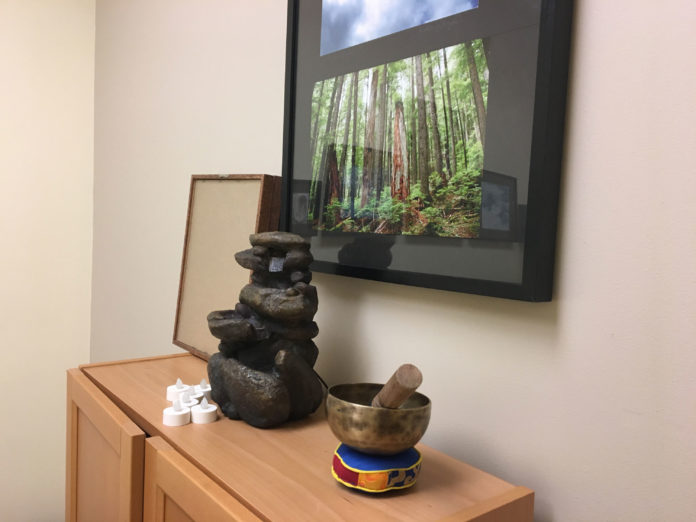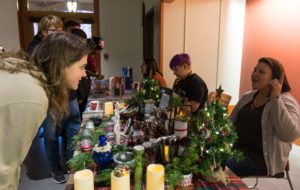
RIZELLE ROSALES; Mast Magazine Editor; rosalera@plu.edu
Every year, the day after Halloween marks the beginning of the holiday takeover: grocery stores, shopping malls and radio stations take on the task of proclaiming the coming of Christmas yet again. Though the Christmas narrative dominates the winter season, junior transfer student Aziza Ahmed is dedicated to giving representation and visibility to other faith and non-faith traditions this season and beyond.
Ahmed is this year’s Interfaith Coordinator, a new position at Campus Ministry. The role is largely funded by the Interfaith Youth Core (IFYC), a national non-profit organization that is dedicated to cultivating interfaith leaders and communities at college campuses across the United States.
“My work is mainly behind the scenes,” Ahmed said. “A lot of it is trying to answer this big question of ‘how do we create a campus climate that welcomes, or even acknowledges, religious and value-based identity?”
Interfaith cooperation consists of common action, respect and dialogue between religious or non-faith belief systems and worldviews. The goal of interfaith work is not to homogenize beliefs, but rather facilitate the conversations, education and engagement to build an atmosphere of respect and understanding despite differences.
“How do we create a campus climate that welcomes, or even acknowledges, religious and value-based identity?”
-Aziza Ahmed, junior
With these goals in mind, Ahmed’s biggest project as the Interfaith Coordinator is tackling this year’s Celebration of Light (read more on page 5). This Pacific Lutheran University tradition is typically a tree-lighting ceremony, but this year’s celebration included interfaith tables from various traditions, giving exposure to more than just Christmas for the winter holidays.
The value of interfaith practice is not unique to PLU’s campus. In fact, it is essential to implementing Lutheran higher education as a whole. According to the writings of Lutheran scholar Martha E. Stotz, the Lutheran traditions surrounding diversity, freedom of religion and taking care of one’s neighbors see interfaith practice not as a luxury, but as a necessity.
Stotz describes Lutheran higher education as a “third pathway” that diverges from both sectarian and secular education. Sectarian methods promote education and practice for a specific religious tradition. The secular method acknowledges religion in an exclusively academic sphere, avoiding conversation about faith and practice as a part of students’ daily lives and identities.

Alternatively, this third pathway of Lutheran higher education provides an opportunity to teach religion in an academic context and allow critical reflection and exploration into the meaning of faith and practice for students. This results in building and promoting religious literacy and interfaith understanding that enriches both campus climate and learning environments.
Many people today face the harsh realities of religious discrimination. Religious and non-faith practices that deviate from Christmas can be misunderstood, misinterpreted and misrepresented. Increasing educational and interactive programming around religious education can help people share their story and listen to others as well.
“I’d like to see a world where people can come as they are. For me, that means showing up in a space being Muslim. Being Somali. Being woman.”
-Aziza Ahmed
Organizations like the IFYC allocate funds and educational resources to provide the necessary tools and support for student leaders and faculty members across the country. This includes guides, case studies, one-on-one support from IFYC staff and grants that allow campus communities to organize and take action.
“I think religious identity, regardless of how often we talk about it, is something we bring with us everywhere we are,” Ahmed said. Regardless of faith or non-faith affiliation, Ahmed explained that everyone has a set of values that informs their identity. “You have a value-based identity, so you take those values with you, too.”
At PLU, Ahmed’s voice does not stand alone. The combined efforts of the Interfaith Working Group continue to bring the interfaith visibility to the forefront of PLU’s religious consciousness. This committee of students, faculty and staff collaborate to create tangible progress on campus.
The Interfaith Working Group sponsored the creation of the Multi-faith Meditation and Prayer Space, and established a half-hour morning time slot every first Friday of the month for Interfaith Chapel Break. The group meets once a month to organize current projects, brainstorm programs for the future, process feedback and assess past implementation.
Ahmed sees the group expanding in the future. “There’s power in numbers,” she explained. “We need more people who care about this work.”

Aside from recruitment, Ahmed plans to increase visibility on campus by using the Four E’s: engagement, exploration, examination and engagement. By organizing events that aim to educate and give representation to various faith and non-faith practices, it communicates a message of inquiry and acceptance from within the community.
“I’d like to see a world where people can come as they are,” Ahmed said. “For me, that means showing up in a space being Muslim. Being Somali. Being woman.”
This drive towards interfaith representation and understanding in the PLU community is part of a national movement in addressing interfaith differences and strengthening bonds across communities. To anyone who has interest in furthering this mission, Ahmed said “Come with a passion, and we’ll welcome you with open arms.”
 Campus Safety Incident Reports
Campus Safety Incident Reports Watch Now
Watch Now




















